China’s New City of the Steppes
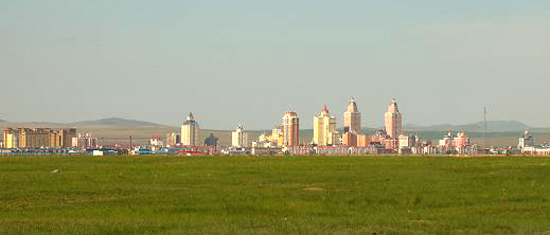
Op/Ed Commentary: Chris Devonshire-Ellis
Jun. 17 – Arriving at Manzhouli is a somewhat surreal experience – a two and a half hour flight north of Beijing, it appears, Las Vegas-like, in an area otherwise largely devoid of human civilization. Deep in the Mongolian steppes, this is a land of blue skies and green pastures, more akin to Chingghis Khan’s wanderlust than to modern China’s commerce. Yet it rises, proud and steadfast, on the tri-border area of the Autonomous Region of Inner Mongolia, with Russia directly to the north and Mongolia to the west. That the city exists at all is down to the Japanese – when building rail links across the area looking to place heavy industry and supplies from Eastern Russia and China to send to Japan, they needed to fuel the trains. Massive coal deposits were found here, and open cast coal mining gave Manzhouli a reason to exist. In an area that has changed hands between Mongolia, Russia, Japan and China over the centuries, this is a city now fueled not just by coal, but by Siberian lumber and Russian trade.
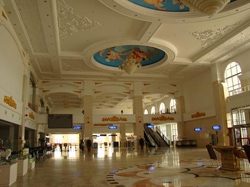
Manzhouli Airport
China expects the region to take off, as is evident upon arrival. With a brand-new terminal boasting Russian style murals on the ceilings, Manzhouli airport is capable of handling several million passengers a year. That’s impressive for a city largely divided into two communities – old Manzhouli, with its coal mining and related heavy industry, and shining new Manzhouli, with its lumber, trade, reprocessing and tourism industries. The combined population of both is little more than 300,000.
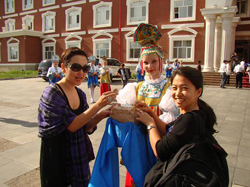
Dezan Shira & Associates staff Marina Romanova (Russia Briefing) and Jessica Tou (International Marketing) are welcomed in traditional style with bread, salt and blue Mongolian silk scarves
As guests of the local government, we were met by police escort and treated royally. The Manzhouli fact finding mission was organized by the Business Advisory Council and Secretariat of the Greater Tumen Initiative, a wing of the United Nations Development Program that focuses on Northeast Asia, and China, Russia, Mongolia and Korea in particular. Some 25 senior level delegates, including overseas consular officials, venture capitalists and executives from interested businesses as far away as the United States, Europe, Mongolia and China attended the mission.
With Manzhouli holding the position of China’s largest inland port – this city of the steppes has a multibillion dollar economy, handles 60 percent of all Sino-Russian trade, and hosts its own lumber commodities exchange – the time is ripe to evaluate exactly what is going on in this far flung corner of China.
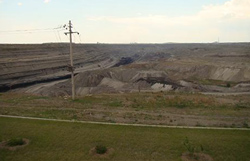 Mining is still a major industry here, and is sited about 25 kilometers west in the old city of Manzhouli. With open cast mining commencing here in 1902 to service the rail network that would become the Trans-Siberian route, Manzhouli holds 10 billion tons of coal resources and is a major production base for the nation. Other heavy industries are also concentrated here, such as brick making, cement works and so on. Just 1 percent of the estimated coal reserves have been extracted from the Manzhouli deposits, and with more refined modern mining and processing techniques, it stands to be in production for many years to come.
Mining is still a major industry here, and is sited about 25 kilometers west in the old city of Manzhouli. With open cast mining commencing here in 1902 to service the rail network that would become the Trans-Siberian route, Manzhouli holds 10 billion tons of coal resources and is a major production base for the nation. Other heavy industries are also concentrated here, such as brick making, cement works and so on. Just 1 percent of the estimated coal reserves have been extracted from the Manzhouli deposits, and with more refined modern mining and processing techniques, it stands to be in production for many years to come.
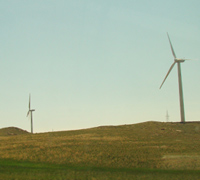 Aware of the desolation caused by the massive pits of open cast mining, the Manzhouli government is also investing significantly in green alternative energy sources – wind farms exist here and signal a contrast between polluting and non-polluting energy industries within just a few square miles. Manzhouli represents the dirty, coal dust filled past as well as the clean, green future of energy. The comparisons could not be more apt.
Aware of the desolation caused by the massive pits of open cast mining, the Manzhouli government is also investing significantly in green alternative energy sources – wind farms exist here and signal a contrast between polluting and non-polluting energy industries within just a few square miles. Manzhouli represents the dirty, coal dust filled past as well as the clean, green future of energy. The comparisons could not be more apt.
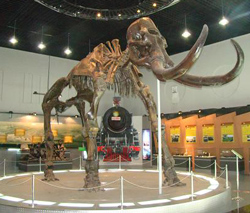 The city also boasts the National Mining Museum, a fascinating stop over that also contains one of the two mammoth fossils found to date in China – the other is in the Hohhot National History Museum. Situated next to a life sized reconstruction of one of the early mining locomotives, the mammoth towers over the smaller engines.
The city also boasts the National Mining Museum, a fascinating stop over that also contains one of the two mammoth fossils found to date in China – the other is in the Hohhot National History Museum. Situated next to a life sized reconstruction of one of the early mining locomotives, the mammoth towers over the smaller engines.
Further west still is the massive Lake Hulun, the fifth largest in China, covering some 2,600 square kilometers. Some tourism 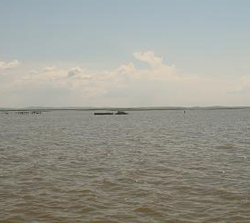 exists here, however the area is largely unspoiled and devoted to fish production – harboring over 1,000 different species.
exists here, however the area is largely unspoiled and devoted to fish production – harboring over 1,000 different species.
Annual fish production is around 8,000 tons, plus 100 tons of shrimp, 4 kilograms of high quality fresh water pearls, and 1.5 million crayfish. The lake is also one of the key reed production areas in China.
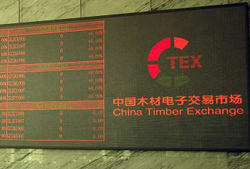 Back to modern Manzhouli, it’s the lumber trade that predominates. The China timber exchange is based here, with trading in different types of woods nearly all conducted online and a daily trading volume of some US$6 million. Manzhouli is China’s largest lumber base, dealing almost exclusively with Siberian lumber brought down directly from Russia.
Back to modern Manzhouli, it’s the lumber trade that predominates. The China timber exchange is based here, with trading in different types of woods nearly all conducted online and a daily trading volume of some US$6 million. Manzhouli is China’s largest lumber base, dealing almost exclusively with Siberian lumber brought down directly from Russia.
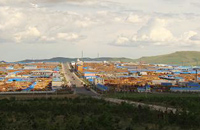 The city’s lumber processing zone is huge and contains both local and JV partners in wood processing and saw mills, much of it destined for markets in Japan and Europe. The scale of the operations is staggering. Some 20 trains daily, each loaded with 60 full sized containers, transport lumber from Russia to Manzhouli for processing.
The city’s lumber processing zone is huge and contains both local and JV partners in wood processing and saw mills, much of it destined for markets in Japan and Europe. The scale of the operations is staggering. Some 20 trains daily, each loaded with 60 full sized containers, transport lumber from Russia to Manzhouli for processing.
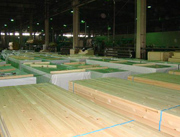 Manzhouli processes some 3.5 million cubic meters of wood each year, and produces planks and lumber, to upstream industries supplying furniture, timber framed houses, solid windows, doors and so on. Over 100 lumber processing businesses are based in Manzhouli to service the demand. Being on the main rail route to Beijing connects Manzhouli efficiently to major ports for export.
Manzhouli processes some 3.5 million cubic meters of wood each year, and produces planks and lumber, to upstream industries supplying furniture, timber framed houses, solid windows, doors and so on. Over 100 lumber processing businesses are based in Manzhouli to service the demand. Being on the main rail route to Beijing connects Manzhouli efficiently to major ports for export.
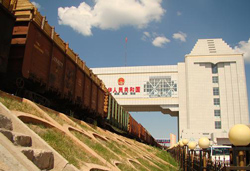 The border itself with Russia is a mighty affair, and is divided into three sections: road, rail and pedestrian, each with their own passageways and specific points of entry and exit. Sino-Soviet history is also recorded here, with Manzhouli being the point where senior leaders of both countries would cross during revolutionary times.
The border itself with Russia is a mighty affair, and is divided into three sections: road, rail and pedestrian, each with their own passageways and specific points of entry and exit. Sino-Soviet history is also recorded here, with Manzhouli being the point where senior leaders of both countries would cross during revolutionary times.
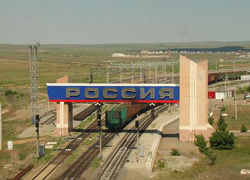 Marked by the “Red Passage” Museum, the exhibits demonstrate the strategic importance that Manzhouli had when Chinese-Russian Communist revolutionaries regularly traveled between Moscow and Beijing.
Marked by the “Red Passage” Museum, the exhibits demonstrate the strategic importance that Manzhouli had when Chinese-Russian Communist revolutionaries regularly traveled between Moscow and Beijing.
In terms of nightlife, given the cities proximity to Russia, it is also no surprise to find a great deal of Russian culture on display. The city hosts the largest Russian wooden doll in the  world, a five story edifice that contains shops, a restaurant and a bar, while Russian dancers, ballets and entertainers are often to be found performing at cabaret shows and festivals in the city. It gives Manzhouli very much a frontier, rock and roll type ambiance, as cultures collide and mix. Vodka is the drink of choice, and Russian restaurants and stores line the busy pedestrian streets in the city’s downtown area. It’s not dissimilar to the Wild West of American lore.
world, a five story edifice that contains shops, a restaurant and a bar, while Russian dancers, ballets and entertainers are often to be found performing at cabaret shows and festivals in the city. It gives Manzhouli very much a frontier, rock and roll type ambiance, as cultures collide and mix. Vodka is the drink of choice, and Russian restaurants and stores line the busy pedestrian streets in the city’s downtown area. It’s not dissimilar to the Wild West of American lore.
The scale of the lumber trade becomes apparent when one views the size of the freight trains coming across from Russia into China. Arriving with 60 containers packed with lumber, they return to Russia completely empty. The twin Russian city of Zabaykalsk lies just next to Manzhouli, populated mainly by traders and as a crossing point for Russian tourists into China. With the combined border crossings handling some 50 million passengers annually, there is plenty of scope for development both of tourism and in trade.
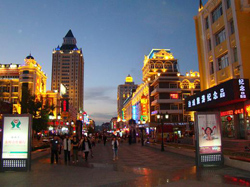
Evening falls on downtown Manzhouli’s pedestrian shopping area
Manzhouli demonstrates the impact that China’s development is having on its remote borders. While much comment and media attention circulates about China’s trade with Europe and the United States, it is however China’s border areas that are a true demonstration of the impact the development of the nation is having on its neighbors. What is also apparent is the size and demand for raw materials – Russia’s Siberian forestry industry is providing the raw materials, China provides the value added services such as processing. The scale of these operations is hard to imagine without taking a firsthand look. Much of the new China opportunities lie for the foreign investor along China’s borders, and they are not just relying on old, established industries. Manzhouli is expanding its processing operations to include the mass processing of Russian furs and skins, with the leather and tanning industries set to also become important players in the city, again relaying on Russian, and to some extent, Mongolian raw materials. China’s borders are full of opportunities for the savvy investor, and being relatively remote and unknown can be a case for the early arriving businessman to catch the fat trade worm. Development issues also such as the creation of entire new cities is taking place.
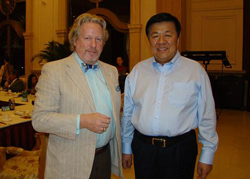
Chris Devonshire-Ellis with Manzhouli Party Secretary Wu Haofeng
Access to government officials and the introduction of border specific investment and trade incentives can make such locations attractive destinations to research and pursue. For Manzhouli itself, businesses involved in lumber, leather and coal related industries, along with an increasing tourism sector could do far worse than consider China’s remote locations and the unique potential they have for development. The type of development that Manzhouli is experiencing is also taking place in cities as diverse as Dandong (near North Korea), Korgas (near Kazakhstan), Pingxiang (near Vietnam), Urumqi (near Kazakhstan) and Zhangmu (near Nepal) amongst others. Turkish marble clad the walls of Manzhouli’s Timber Exchange, while Russian architects advise on construction and rail. German technology supplies the saw mills, and Japanese technology deals with pressure treatments. The need for China-focused investors and salesmen to broaden their horizons in the country has arrived. The new China dynamism of international trade is concentrated on its strategic border cities.
Chris Devonshire-Ellis is the principal of Dezan Shira & Associates, who have been handling foreign investment into China for 18 years. The firm has clients and government relations in each of China’s provinces, and is also operational in Russia, India and Vietnam. Please contact the firm at info@dezshira.com for further information about investment in China’s border regions or for other trade or corporate legal and tax advice about trade and establishment of operations in China.
The Greater Tumen Initiative is a joint mechanism of the four member countries: China, Mongolia, the Republic of Korea and the Russian Federation. It is supported by the United Nations Development Program and other donors. The GTI provides a unique multilateral forum for the member countries to identify and implement regional initiatives that encourage economic growth, investment, multilateral trade, and contribute to peace and stability in the North-East Asia region. The Business Advisory Council of the GTI is a platform for the permanent dialogue between government and private sector, established with support of the United Nations Office for Partnership. The BAC has a current membership of approximately 60 members consisting of Senior business leaders from Northeast Asia and foreign investors operating in the region, and is private sector led and funded. The Business Advisory Council is a platform to provide a dialogue, information exchange, advocacy, networking (through business delegations, fact finding missions, member surveys, position papers, regional analysis, matchmaking, etc.) for companies active and interested in the GTI region. The BAC has held recent meetings in Vladivostok, Ulaanbaatar, Changchun, Shanghai and Beijing, and has its next multilateral meeting in Changchun in September 2010. For more information about the GTI and membership applications, please see the program’s web site.
Related Reading
Profiling all 14 of China’s Neighboring Countries and Border Points
Daily business news from Russia
Heading for the Borders – Trade Opportunities along China’s Frontiers
- Previous Article SAT Issues New Notice Regarding the Interest Income of Overseas Financial Branches
- Next Article World Bank Predicts Solid Growth for China Despite Real Estate Sector, European Debt Crisis









